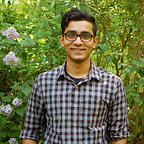Recap: Transit Techies NYC #7: 7 Minute Delay
A quick recap of Transit Techies NYC #7: 7 Minute Delay, a Meetup held on Wednesday, March 20, 2019
As usual, wonderful hosts Tyler Green and Kohzy Koh kicked off the evening with a funny bit. This time, they launched into a quick trivia session about the history behind the newly completed Hudson Yards (where Intersection hosted this Meetup). Amongst other things, I learned that the new Vessel sculpture has been… let’s say, compared to many different things. Great stuff as always!
goodservice.io — Sunny Ng
First up was Sunny Ng, who presented his goodservice.io project. A few years ago, the MTA started to publish real time service status tables for the subway system. As these things go, New Yorkers began to mock what the MTA data considered “good service” so Sunny set out to build a better alternative.
goodservice.io compares real-time headways (the time between trains arriving at a platform) to scheduled headways in order to provide a better understanding of current subway performance. Sunny then refined his implementation to incorporate local vs express trains, segment subway lines into different service sections (that may be active concurrently), and account for any ad hoc service changes. The final output is a more accurate notion of subway status based on headway at that exact moment:
He also built a nifty Slack integration so you can quickly check service status before leaving work. Finally, a Twitter bot posts any service interruptions to Twitter in real-time and Sunny showed us a few examples where it’s even announced delays before the MTA’s official account. You can learn more and follow goodservice.io here. 🚋
Accessibility Principles at Sidewalk Labs — Samara Trilling
Samara Trilling, the accessibility lead at Sidewalk Labs, was up next to discuss the SWL’s efforts to incorporate accessibility by design into their Quayside (TIL: pronounced “key-side”) development. SWL’s perspective is that intentionally designing cities for underrepresented and marginalized experiences makes the final product better for everyone. Towards this end, SWL aims to co-create accessibility principles for future cities by working with accessibility groups that have lived experience in their cities. 🙌
What do accessibility and transit entail in smart cities of the future? To answer this question, Samara’s team has been leading many co-design brainstorming sessions with accessibility groups from the Toronto area. These co-design sessions have touched on topics including wayfinding for public transit and the physical design of transit infrastructure.
Ideas from these sessions were then prototyped and iterated upon at a community hackathon at SWL’s experimental workspace in Toronto. One idea I found particularly interesting was an augmented reality feedback interfaces for public parks; this could make it easier for certain users to acquire important information about their immediate surroundings.
The feedback and ideas from these sessions has been distilled into a set of accessibility principles that SWL released as a public draft for further review and feedback.
Wayfinder3D — Will Geary
Next up was Will Geary, Transit Techies NYC’s first repeat speaker 👏, to discuss his Wayfinder3D project. Will’s newest project takes multimodal directions from Google Maps API and compares them by “racing” different modes against each other in a nifty animation.
Will also created a simple command line API to run Wayfinder3D. He demonstrated the app live by inputting Hudson Yards as a starting point and the George Washington Bridge as the destination. The command launched a visualization of car, subway and bike labels racing to the GW bridge. Initially, the car had a sizable lead, but the crowd went wild when the subway burst forward to the front of the pack. Ultimately though, the car won the race. 😕
Will mentioned some additional visualization ideas he’s considering adding to Wayfinder3D, including representing CO2 emissions for each mode with a growing bubble or bar chart. In terms of environmental, time, and monetary cost, it may be interesting to evaluate ride-share in this format as well. If you want to check out or contribute to the project, you can do so here.
Brooklyn Bus Network Redesign — Eric Goldwyn
Last up was Eric Goldwyn from NYU’s Marron Institute to talk about his research with Alon Levy on redesigning the MTA bus network in Brooklyn. Bus ridership has been steadily in decline for many years, while subway usage in the city has increased. Often, transit planners share best practices for increasing bus utilization and service quality, so Eric’s group set out to understand how such best practices could be used to actually increase bus ridership in Brooklyn.
To do this, the team modeled the current bus system and tweaked their model to measure the potential impact of several best practices in transit network design. For example, they considered how enforcing riders to prepay their transit fare, instead of paying when boarding the bus, could streamline services by reducing the time a bus is idling at a stop.
Interestingly, the group found that consolidating tightly bunched stops was the most impactful way to improve bus performance; their model suggested that doubling the average distance between stops to 1500 ft in Brooklyn could lead to a 7% increase in time efficiency. You can learn more about Eric’s work here.
Thanks for reading! If you enjoyed this post, please 👏 and share to any transit enthusiasts or NUMTOTS in your life.
If you like projects like these, please come say hi at the next Transit Techies Meetup! You can find me on Twitter, LinkedIn, and Medium.
